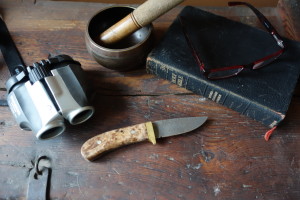Robert Ray, in his book “The Weekend Novelist Re-Writes the Novel”, provides the following tip: “Plant a sacred object on page one that recurs in Acts Two and Three. By the midpoint, that sacred object could be growing into a symbol. Symbols can make you famous. That sacred object, grown into a symbol, should make you proud. A happy writer.”
I know the importance of characters and setting in a story. But objects? What’s he talking about? With the lure of “famous, proud and happy” on the hook, I decided to find out.
Robert Ray recommends making lists and putting them into beautiful charts, appealing to my hyper organizational inner self. The list has the character names, objects associated with them and the scene in which they first appear and when they last appear.
Something like this:
Character Object Entry Exit
Hero ring Scene 1 Scene 8
Antagonist 1 book Scene 1 Never seen again
Antagonist 2 crooked staff Scene 62 Scene 62
You want to avoid pulling out an essential object at the end of the story and not have it planted at the beginning of the book. You also don’t want to leave an important object (like a gun) sitting on the front step of your book and then the reader wondering what the heck happened to that gun when you don’t mention it again.
Tracking objects will help prevent magically appearing bunnies or disappearing socks.
Repetition of objects is also important – as objects reappear (generally more than 3 times) they have the potential to transform from objects into symbols and that will start to tighten your story.
Why is it important to have objects attached to a character? Here’s another little tip I found (online and now I can’t find the source): “Objects externalize ideas and emotions and therefore, when used correctly, create effect.”
The more symbolic the object, the better. Chose your objects wisely. What would the “Wizard of Oz” be without the ruby slippers? The plot line could still be the same but it would be like strolling along an ocean beach with no seashells. And the “Lord of the Rings” without the “one ring” would be a very short book.
Objects can be anything.
Common examples are books, jewelry, clothing, toys, tools, weapons, vehicles, foods or drinks and important papers or documents. The characters and events may suggest the objects to be selected. But really good objects are inventive and original. Objects, just like characters, should have detail and background. The slippers in the Wizard of Oz are ruby (not red) and are slippers (not shoes). They have a history: they first belonged to the wicked witch of the east.
To figure out what objects I had in my story, I gave myself 15 minutes to brainstorm and made a list of any object that appears more than once or any object which was important for the plot line or was unique. At first, it was sadly a short list of only 2 objects. How can this be? So much for happiness! Then as I thought more about it, more objects came to me and I was surprised to find myself surrounded by them like I was at a flea market. I realized that I was sloppy over these objects – not giving them enough detail and sometimes forgetting about them in the first act of the book and leaving them behind like discarded tissue.
As I created my object list, I found myself getting excited about my book again. My objects became more concrete and detailed. I began to appreciate how objects can add depth to a character without adding a lot of words. I was delighted by the insight that an object can show, instead of tell, an aspect about a character. For example, a rich character has different potential objects than a poor character, or a religious one or a young one.
Going through your book and making an object list is a different method to attack the editing process. It gets you digger deeper into your story and thinking about it from a different perspective.
Try the following writing exercise for your book, as recommended by Robert Ray: chose 2 objects – one for your protagonist, another for one of your antagonist. Track both objects through the manuscript. Each time the object is present, write down the scene name (and give the scene a name!). Note if the object is in narration, description or dialogue. Tracking objects helps train your brain and helps you focus your writing, making it tighter. Now try changing the object to something else – does this make any effect on the story? Give yourself twenty minutes to do this exercise and you might be surprised. And you might find yourself on the path to being famous, proud and happy.
